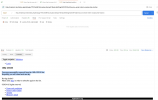pradeep sharma
Active Member
Dear Twested1919,
I have identified a critical malfunction within the List-Unsubscribe mechanism, specifically when activated via Google's interface, which fails to execute as intended. This issue has been replicated multiple times, confirming its persistence.
Issue Analysis:
Primary Concern:The fundamental issue stems from the fact that the current implementation of the List-Unsubscribe button directs to a URL necessitating user interaction, specifically, the submission of an unsubscribe reason. This contradicts the expected behavior, where a simple, non-interactive URL should suffice for unsubscribing. The operation is hindered when Google, employing proxy servers, attempts to access this URL, expecting a straightforward action. The current header for the List-Unsubscribe function is as follows:
The preferred structure should eliminate interactive elements, as illustrated below:
Secondary Concern: Regarding the configuration of the "List-Unsubscribe header email," it is currently assigned within the customer group settings. I propose relocating this option to the delivery server settings for the following reasons:
Additionally, it's imperative to clarify the role and functionality of the "List-Unsubscribe-Post" header, specifically:
This directive informs the client, such as Google, that the unsubscribe process is designed to be executed silently in the background. Upon a user's activation of the List-Unsubscribe button, the request is processed without redirecting the user to the unsubscribe webpage or presenting a pre-filled email compose window for sending an unsubscribe request. This ensures a seamless and non-intrusive user experience, facilitating the unsubscribe action to occur in both web and email modalities without explicit user redirection or interaction. It is crucial to differentiate this functionality from the standard unsubscribe process to prevent any confusion regarding the operational flow of unsubscribe requests.
In light of the aforementioned issues and recommendations, I urge the consideration and prompt resolution of these concerns to enhance the efficacy and reliability of the List-Unsubscribe functionality.
Thank you for your attention to these matters.
Best Regards,
Pradeep
########### attached pics of user reported spam increased after migrating to mailwizz keeping smtp,domain,data,and lists same...




I have identified a critical malfunction within the List-Unsubscribe mechanism, specifically when activated via Google's interface, which fails to execute as intended. This issue has been replicated multiple times, confirming its persistence.
Issue Analysis:
Primary Concern:The fundamental issue stems from the fact that the current implementation of the List-Unsubscribe button directs to a URL necessitating user interaction, specifically, the submission of an unsubscribe reason. This contradicts the expected behavior, where a simple, non-interactive URL should suffice for unsubscribing. The operation is hindered when Google, employing proxy servers, attempts to access this URL, expecting a straightforward action. The current header for the List-Unsubscribe function is as follows:
Code:
https://domain.com/lists/gr304pp8ax6c0/unsubscribe/jd3435k2bkd51/cr264rqtezdb7?source=email-client-unsubscribe-button>, <mailto:contact@domain.com?subject=Campaign-Uid%3Acr264rqtezdb7%20%2F%20Subscriber-Uid%3Ajd3435k2bkd51%20-%20Unsubscribe%20request&body=Please%20unsubscribe%20me%21>The preferred structure should eliminate interactive elements, as illustrated below:
Code:
https://domain.com/lists/gr304pp8ax6c0/unsubscribe/jd3435k2bkd51/cr264rqtezdb7/unsubscribe-direct?source=email-client-unsubscribe-button>, <mailto:contact@domain.com?subject=Campaign-Uid%3Acr264rqtezdb7%20%2F%20Subscriber-Uid%3Ajd3435k2bkd51%20-%20Unsubscribe%20request&body=Please%20unsubscribe%20me%21>Secondary Concern: Regarding the configuration of the "List-Unsubscribe header email," it is currently assigned within the customer group settings. I propose relocating this option to the delivery server settings for the following reasons:
- Domain Email Flexibility: When utilizing the same customer group for multiple clients, the limitation to use a uniform domain email, as determined by the customer group settings, restricts the adaptability to employ distinct domain emails for different clients. Should the single domain designated in the customer group face blacklisting, it jeopardizes the email deliverability and reputation for all clients within that group. Enabling the specification of custom domain emails at the delivery server level would provide the necessary flexibility to assign unique email-domain per client as per the delivery server, thereby mitigating the risk associated with domain blacklisting.
- Infrastructure Segregation: As an Email Service Provider (ESP), the infrastructure, encompassing domains and IP addresses, is vulnerable to the detrimental actions of a subset of clients. To safeguard the integrity and reliability of the infrastructure, it is advisable to segregate services and operational components. By allowing the "List-Unsubscribe header email" configuration within the delivery server settings, akin to the bounce server configuration, it would facilitate a more granular and isolated management of services. This approach would enable the addition of multiple list-unsubscribe servers, enhancing operational resilience and reducing the risk of cross-contamination among clients.
Additionally, it's imperative to clarify the role and functionality of the "List-Unsubscribe-Post" header, specifically:
Code:
List-Unsubscribe-Post: List-Unsubscribe=One-ClickThis directive informs the client, such as Google, that the unsubscribe process is designed to be executed silently in the background. Upon a user's activation of the List-Unsubscribe button, the request is processed without redirecting the user to the unsubscribe webpage or presenting a pre-filled email compose window for sending an unsubscribe request. This ensures a seamless and non-intrusive user experience, facilitating the unsubscribe action to occur in both web and email modalities without explicit user redirection or interaction. It is crucial to differentiate this functionality from the standard unsubscribe process to prevent any confusion regarding the operational flow of unsubscribe requests.
In light of the aforementioned issues and recommendations, I urge the consideration and prompt resolution of these concerns to enhance the efficacy and reliability of the List-Unsubscribe functionality.
Thank you for your attention to these matters.
Best Regards,
Pradeep
########### attached pics of user reported spam increased after migrating to mailwizz keeping smtp,domain,data,and lists same...




Last edited:

